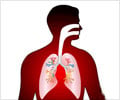Research indicates that most children have had respiratory syncytial virus (RSV) and have suffered symptoms no worse than a bad cold.

A new technique for studying the structure of the RSV virion and the activity of RSV in living cells could help researchers unlock the secrets of the virus, including how it enters cells, how it replicates, how many genomes it inserts into its hosts – and perhaps why certain lung cells escape the infection relatively unscathed. That could provide scientists information they need to develop new antiviral drugs and perhaps even a vaccine to prevent severe RSV infections.
"We want to develop tools that would allow us to get at how the virus really works," said Philip Santangelo, an associate professor in the Wallace H. Coulter Department of Biomedical Engineering at Georgia Tech and Emory University. "We really need to be able to follow the infection in a single living cell without affecting how the virus infects its hosts, and this technology should allow us to do that."
The research was supported by the National Institutes of Health's National Institute of General Medical Sciences and published online ahead of print in the journal ACS Nano on December 30, 2013. While RSV will be the first target for the work, the researchers believe the imaging technique they developed could be used to study other RNA viruses, including influenza and Ebola.
"We've shown that we can tag the genome using our probes," explained Santangelo. "What we've learned from this is that the genome does get incorporated into the virion, and that the virus particles created are infectious. We were able to characterize some aspects of the virus particle itself at super-resolution, down to 20 nanometers, using direct stochastic optical reconstruction microscopy (dSTORM) imaging."
RSV can be difficult to study. For one thing, the infectious particle can take different forms, ranging from 10-micron filaments to ordinary spheres. The virus can insert more than one genome into the host cells and the RNA orientation and structure are disordered, which makes it difficult to characterize.
Source-Eurekalert
 MEDINDIA
MEDINDIA


 Email
Email




